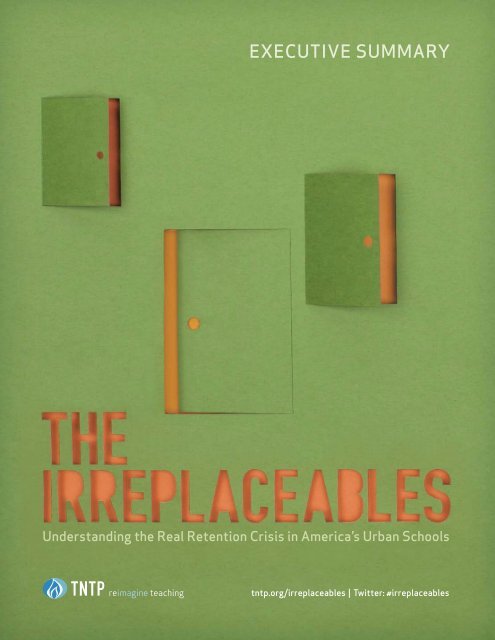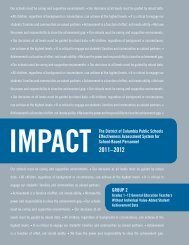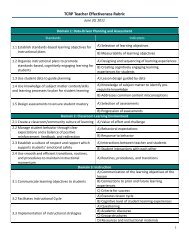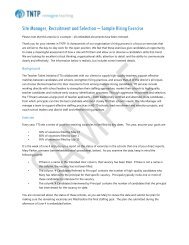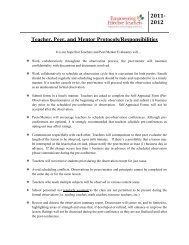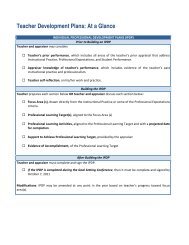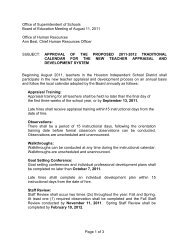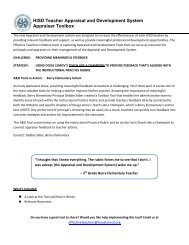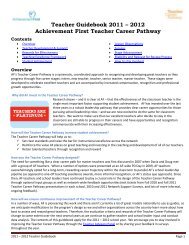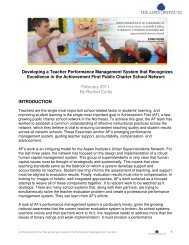The Irreplaceables Executive Summary - TNTP
The Irreplaceables Executive Summary - TNTP
The Irreplaceables Executive Summary - TNTP
Create successful ePaper yourself
Turn your PDF publications into a flip-book with our unique Google optimized e-Paper software.
EXECUTIVE SUMMARY<br />
EXECUTIVE SUMMARY<br />
Understanding the Real Retention Crisis in America’s Urban Schools<br />
tntp.org/irreplaceables | Twitter: #irreplaceables
2<br />
EXECUTIVE SUMMARY<br />
Urban schools nationwide are facing a<br />
teacher retention crisis—but not the one<br />
that everyone talks about<br />
Discussions of teacher turnover usually focus on how many teachers leave schools each year, without regard for<br />
their performance in the classroom. This oversimplification masks the real teacher retention crisis: not only a<br />
failure to retain enough teachers, but a failure to retain the right teachers.<br />
This paper examines the real retention crisis through the experiences of a group we call the “<strong>Irreplaceables</strong>”:<br />
teachers who are so successful that they are nearly impossible to replace. Teachers of this caliber provide more<br />
engaging learning experiences for students and help them achieve five to six more months of learning each year<br />
than students of low-performing teachers—academic results that can be life-changing.<br />
Of the 90,000 teachers we studied across four large, geographically diverse urban school districts, we estimate<br />
that about 20 percent are <strong>Irreplaceables</strong>. When one of them leaves a low-achieving school, it can take 11 hires<br />
to find just one teacher of comparable quality.<br />
<strong>The</strong>se are the teachers our urban schools desperately need to keep. Yet we found that they are ignored and<br />
undervalued at almost every turn. <strong>The</strong>ir experience illuminates the true obstacles to turning around chronically<br />
low-performing schools and raising the status of the teaching profession.<br />
FIGURE 1 | WHO ARE THE IRREPLACEABLES?<br />
OUTSTANDING TEACHERS GETTING GREAT RESULTS IN SCHOOLS NATIONWIDE<br />
High-performing<br />
teacher<br />
1 year 2 years<br />
Low-performing<br />
teacher<br />
IRREPLACEABLES<br />
Top 20% of teachers in<br />
studied districts, as gauged<br />
by district data<br />
STUDENT IMPACT<br />
Generate 5 to 6 more months of<br />
student learning each year than<br />
a poor performer<br />
SCOPE<br />
4 urban districts,<br />
with 2,100 schools, 90,000<br />
teachers, 1.4 million students<br />
<strong>The</strong> “<strong>Irreplaceables</strong>” are teachers so successful that they are nearly impossible to replace.<br />
Estimates of <strong>Irreplaceables</strong> percentage based on teachers with value-added or growth data; District A high performers: 21%; District B<br />
high performers: 20%; District C high performers: 20%; District D high performers: 18%; Student impact estimates calculated following the<br />
methodology of Hahnel and Jackson (2012). Source: District data from SY 2009-10 and SY 2010-11.
<strong>The</strong> Real Crisis: Negligent Retention<br />
Knowing the power of great teachers, one would expect schools to be sharply focused on keeping far more of<br />
their best teachers than their lower performers. Instead, they retain all teachers at strikingly similar rates; and<br />
about half of all <strong>Irreplaceables</strong> leave within their first five years (Figure 2).<br />
This means too many <strong>Irreplaceables</strong> are leaving too early—we estimate that the nation’s 50 largest<br />
school districts lose approximately 10,000 every year—while too many struggling teachers remain<br />
for too long. We found that 1 in 10 classrooms in the districts we studied is led by an experienced but lowperforming<br />
teacher. In fact, in these districts, 40 percent of teachers with more than seven years of<br />
experience are less effective at advancing academic progress than the average first-year teacher.<br />
<strong>The</strong> result: Rather than steadily improving the quality of instruction, schools are running in place.<br />
3<br />
EXECUTIVE SUMMARY<br />
FIGURE 2 | SCHOOL RETENTION RATES BY TEACHER PERFORMANCE, 2009-10<br />
86%<br />
87%<br />
89% 88%<br />
77%<br />
72%<br />
75%<br />
79%<br />
District A District B District C<br />
District D<br />
High Performers<br />
Low Performers<br />
Most schools retain <strong>Irreplaceables</strong> and low performers at strikingly similar rates.<br />
School retention defined as teachers remaining at their school from one year to the next.<br />
Source: District data from SY 2009-10 through SY 2010-11.
4<br />
EXECUTIVE SUMMARY<br />
<strong>The</strong> CAUSES<br />
<strong>The</strong>se destructive retention patterns occur mainly because leaders at all levels let them happen. We identified<br />
three main causes of negligent retention:<br />
Principals make too little effort to retain <strong>Irreplaceables</strong> or remove low-performing teachers<br />
Less than 30 percent of <strong>Irreplaceables</strong> plan to leave for personal reasons beyond their school’s control,<br />
and principals’ actions have a significant impact on the decisions of the other 70 percent. We identified<br />
eight simple, low-cost strategies that helped boost teacher retention at the schools we studied—things like<br />
giving positive feedback or public recognition for a job well done. <strong>Irreplaceables</strong> receiving two or more<br />
of these strategies planned to remain at their schools up to six years longer than those who didn’t, yet many<br />
<strong>Irreplaceables</strong> experienced few or none of these strategies. Two-thirds told us that nobody even encouraged<br />
them to return for another year (Figure 3).<br />
Meanwhile, principals rarely attempt to dismiss or counsel out chronically low-performing teachers, though<br />
we found teachers are nearly three times as likely to plan to leave if encouraged to do so. In fact, principals<br />
often work to retain low-performing teachers, even though a brand-new teacher will pay off in improved<br />
performance about 75 percent of the time. Most principals focus on development instead—more than 70<br />
percent insist it is a top priority—even though the average experienced low performer we studied remained<br />
less effective than an average beginning teacher even three years later (Figure 4).<br />
Poor school cultures and working conditions drive away great teachers<br />
At schools that retain high percentages of <strong>Irreplaceables</strong>, principals created cultures of respect and trust, but<br />
were also less likely to tolerate ineffective teaching. Turnover rates among <strong>Irreplaceables</strong> were 50 percent<br />
higher in schools with weak instructional cultures than in those with strong cultures. In three out of the four<br />
districts we studied, retention rates were higher at schools where teachers reported a low tolerance for poor<br />
performance—yet fewer than half of the teachers we surveyed believed that their own school has a low<br />
tolerance for ineffective teaching.<br />
We believe the lesson is clear: Good teachers don’t leave demanding schools that hold them to high<br />
expectations; they leave schools that aren’t serious about good teaching.<br />
Policies give principals and district leaders few incentives to change their ways<br />
In most school districts, smart teacher retention is simply not a priority. In three of the four districts we<br />
studied, only 20 percent of principals agreed that their district had effective strategies to retain its best<br />
teachers. Furthermore, principals in most districts encounter a number of policy barriers that discourage<br />
or prevent them from making smarter retention decisions. Most notably, they are hamstrung by lockstep<br />
teacher compensation systems that are hard-wired to undervalue great teaching. Because these systems award<br />
most raises for seniority and advanced degrees, about 55 percent of <strong>Irreplaceables</strong> earn lower base salaries<br />
than the average ineffective teacher. Not surprisingly, compensation was one of the reasons most<br />
frequently cited by <strong>Irreplaceables</strong> for leaving their schools.
5<br />
FIGURE 3 | TEACHERS REPORTING RECOGNITION AT SCHOOL<br />
“Last year, someone from my school leadership team...”<br />
Informed me that<br />
I am high-performing<br />
Identified<br />
opportunities or<br />
paths for teacher<br />
leadership roles<br />
HIGH-PERFORMING 47%<br />
LOW-PERFORMING 25%<br />
HIGH-PERFORMING 26%<br />
LOW-PERFORMING<br />
31%<br />
EXECUTIVE SUMMARY<br />
Encouraged me to<br />
keep teaching at my<br />
school next year<br />
HIGH-PERFORMING 37%<br />
LOW-PERFORMING 31%<br />
Principals use retention strategies at similar rates for high and low performers.<br />
Source: District B data and survey data. Trends confirmed across districts.<br />
FIGURE 4 | PERFORMANCE COMPARISON OF NEW TEACHERS AND EXPERIENCED<br />
LOW PERFORMERS OVER THREE YEARS<br />
Teacher Median Value-Added Percentile Rank<br />
60<br />
50<br />
40<br />
30<br />
20<br />
10<br />
0<br />
New Teachers<br />
New Teachers<br />
2008-09 to 2010-11<br />
Experienced Low Performers<br />
Experienced Low Performers<br />
2008-09 to 2010-11<br />
2010-11<br />
2008-09<br />
2010-11<br />
2008-09<br />
Low performers rarely improve significantly.<br />
Even three years later, most perform worse than the average first-year teacher.<br />
Median percentile ranks by population scores; Populations defined in SY 2007-08. Source: District C data from SY 2007-08 through SY<br />
2010-11. Trends confirmed across districts.
6<br />
EXECUTIVE SUMMARY<br />
<strong>The</strong> Consequences<br />
Negligent retention has dire consequences for students, teachers, and schools. Specifically:<br />
School turnaround is nearly impossible<br />
Current retention patterns lock our lowest achieving schools into a cycle of failure, keeping them from ever<br />
having enough good or great teachers to improve. Our analysis shows that struggling schools can reach<br />
an average teacher composition after three to four years of smart retention practices, but may<br />
never do so under a pattern of negligent retention (Figure 5).<br />
Put simply, most struggling schools won’t ever have as many high-performing teachers as other schools—and<br />
are unlikely to improve significantly—without making smart retention a top priority.<br />
<strong>The</strong> teaching profession is degraded<br />
<strong>The</strong> neglect of <strong>Irreplaceables</strong> is just one glaring symptom of a wider problem: a profession that has become<br />
one of low performance standards and the lack of respect that accompanies them. Negligent retention<br />
sends the dangerous message that great teachers are expendable and that anyone can make a career out of<br />
teaching, regardless of how well they perform.<br />
Tolerating poor performance keeps ineffective teachers in the classroom indefinitely, demoralizes<br />
outstanding teachers, and allows the entire teaching profession to be defined by mediocrity<br />
rather than excellence.<br />
FIGURE 5 | SIMULATED TEACHER RETENTION PATTERNS IN 10 LOW-PERFORMING SCHOOLS,<br />
EACH WITH 20 TEACHERS<br />
200 Teachers<br />
200 Teachers<br />
End Year 4<br />
NEGLIGENT RETENTION<br />
Start Year 1 YEAR 1 YEAR 2 YEAR 3 YEAR 4 Includes New Hires<br />
14% Low Performers Leave<br />
Low Performers<br />
38<br />
5 leave<br />
5 leave<br />
5 leave<br />
5 leave<br />
34<br />
14% High Performers Leave<br />
High Performers<br />
24<br />
3 leave<br />
4 leave<br />
4 leave<br />
4 leave<br />
25<br />
SMART RETENTION<br />
33% Low Performers Leave<br />
Low Performers<br />
38<br />
13 leave<br />
10 leave<br />
7 leave<br />
7 leave<br />
17<br />
4% High Performers Leave<br />
High Performers<br />
24<br />
1 leaves<br />
1 leaves<br />
1 leaves<br />
1 leaves<br />
36<br />
By changing which teachers leave, low-performing schools can reach<br />
an average teacher composition in a few years.<br />
Number of total teachers is 200. Starting composition is 24 high performers, 138 mid performers, and 38 low performers. Ending composition<br />
for negligent retention is 25 high performers, 141 mid performers, and 34 low performers. Ending composition for smart retention is 36 high<br />
performers, 147 mid performers, and 17 low performers. Analysis only includes schools with a minimum of 7 teachers with value-added or<br />
growth data in each year. Composition data based on an average of 3 years; attrition and pipeline data based on an average of 2 years. Models<br />
using the teacher composition at low- and mid-proficiency schools, defined by school-level math proficiency quintile. Model does not assume<br />
any fluctuation in teacher populations at schools and assumes population of teachers with performance data reflects the effectiveness of all<br />
teachers at these schools. Overall attrition and incoming pipeline rate held steady each year. Source: District D data from SY 2007-08 through<br />
SY 2009-10.
THE SOLUTION: SMART RETENTION<br />
Solving the real teacher retention crisis requires a new approach that revolves around smart retention: keeping<br />
more <strong>Irreplaceables</strong> and fewer low-performing teachers.<br />
This approach could improve the quality of teaching at almost any school right away, and it has the potential<br />
to boost student learning substantially. We believe it represents the best way—possibly the only way—for<br />
low-performing schools to break their cycles of failure, and for the teaching profession to achieve the elite<br />
status it deserves.<br />
Lamenting the low prestige of the teaching profession without addressing the low standards that perpetuate it<br />
will not solve the real retention crisis, nor will focusing on greater accountability for teachers without regard<br />
for the challenging circumstances in which they work. Education leaders at all levels need to embrace the<br />
more difficult, more complex work of demanding better working conditions for teachers along with higher<br />
performance standards. We make two main recommendations for solving the real retention crisis.<br />
7<br />
EXECUTIVE SUMMARY<br />
Make retention of <strong>Irreplaceables</strong> a top priority<br />
A combination of focused strategies, focused leadership and focused policies will help keep the best teachers<br />
in the classroom longer. Education leaders should:<br />
Set a goal of retaining more than 90 percent of <strong>Irreplaceables</strong> annually, and report progress<br />
towards that goal publicly<br />
Overhaul principal hiring, support and evaluation to focus on instructional leadership abilities that<br />
result in smart teacher retention, like the ability and commitment to give teachers frequent, high-quality and<br />
rigorous feedback<br />
Monitor school working conditions and address concerns at the policy and individual school level that<br />
drive away <strong>Irreplaceables</strong><br />
Pay <strong>Irreplaceables</strong> what they’re worth and create career pathways that extend their reach<br />
Protect <strong>Irreplaceables</strong> during layoffs<br />
Strengthen the teaching profession through higher expectations<br />
Education leaders must also address the other side of the retention crisis: the indifference to performance<br />
that has allowed so many unsuccessful teachers to remain in the classroom for years or even decades. This<br />
will require difficult decisions and long-deferred actions, but further delay will only exacerbate the problem.<br />
Set a new baseline standard for effectiveness: Teachers who cannot teach as well as the average firstyear<br />
teacher should be considered ineffective and dismissed or counseled out (unless they are first-year teachers)<br />
Encourage low performers to leave voluntarily by creating alternatives to formal dismissal<br />
Remove the policy barriers to higher expectations, such as forced-placement staffing rules and<br />
onerous dismissal processes<br />
Neither the teaching profession nor our schools can move forward without these changes. Leaders at every<br />
level helped create the real retention crisis; they now have an opportunity—and a responsibility—to help<br />
solve it. <strong>The</strong> alternative is to continue standing by as thousands of <strong>Irreplaceables</strong> every year leave the schools<br />
and students who need them most.
tntp.org


